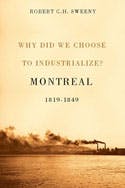
Book Review
Why Did We Choose to Industrialize? Montreal, 1819-1849, 2015
By Robert C. H. Sweeny
Robert Sweeny’s 2016 Sir John A. MacDonald Prize-winning book, the highest honour given by the Canadian Historical Association for a book dealing with Canada, tries to answer “what social and economic changes permitted the industrial revolution?”(311) Or, at least that was the question he once thought he was trying to answer. As he elegantly shows, the question is “simple but wrong” as it grants “autonomy to socio-economic changes and an agency to supra-human processes.”(311) Sweeny’s work brilliantly brings together quantitative historical approaches, prone to being simple and wrong, with a careful reading-in of human agency and choice as mediated by the intersections of status, gender, and class.
Sweeny takes the reader through the theoretical, historiographical, and practical data-driven questions that have driven him over the past four decades. The narrative is structured around a series of data-intensive examinations of nineteenth-century Montreal: commutation records, GIS- rectified re-envisionings of historical maps, property assessments, protested promissory notes, apprenticeship contracts, building size, occupational titles and property ownership, electoral franchise, fire insurance records, school records, and more. The narrative is equally structured by Sweeny’s examination of his own changing interpretation of historical sources, what they mean, and what they have to say about the present.
At the risk of taking an epiphenomenal reading of Sweeny’s text, it may be read as a much- needed corrective to the twenty-first century interpretation of “big data.” Sweeny’s careful reconstruction of significantly detailed aspects of industrializing Montreal can be seen as the historical equivalent of big data, a data paradigm that is “characterized by being generated continuously, seeking to be exhaustive and fine-grained in scope, and flexible and scalable in its production.” (Roy Kitchin, “Big Data, new epistemologies and paradigm shifts”, 2014). The big data question, like the question Sweeny asks, is that of the relationship between sources/data and reality. How can the easily measured or, the measurable at all, be used to construct a meaningful understanding of reality?
In Chapter Six (“C’est un travail dont je n’avais pas d’idée!”) Sweeny develops a complex picture of property and households using the Viger census, the Adams map of the city, and the Doige directories, all remarkable sources for 1820s Montreal, carefully deployed and delicately and critically examined. Each of the three sources “lends itself extremely well to computer- assisted analysis.” (180) The story they tell is consistent, compelling and sensible. Sweeny then asks a key question for our interpretation of modernity “why is it that certain sources are so computer friendly. Is it the structured ordering of reality that makes them appear so modern ... [and] what does this ... hide us from seeing?”(180)
This question, and Sweeny’s attempt to answer it in Chapter Seven (“Towards a Cubist Portrait”), forms the crux of the importance of this book for a contemporary understanding of how to use data, how to interpret big data, and the extreme importance of being very careful in understanding and analyzing one’s own unstated and unconscious theoretical framings when trying to interpret data – historical or otherwise. Sweeny is practising what Kitchin in “Big Data” calls an “epistemology […] in which quantitative methods and models are employed within a framework that is reflexive and acknowledges […] situatedness, positionality and politics.”
And, I would add, the fundamental importance of gender as a category of analysis. While gender as a category of analysis is taken seriously by many historians, Sweeney argues that despite the assumption that “gender is a conceptual tool whose legitimacy within the [historical] profession was established decades ago,” the “neo-liberal transformation of [academia …] has in many ways reinforced the barriers to a gender-based analysis.” (13–4) He shows how many aspects of the economic history of industrialization, often seen as gender-neutral, are anything but: changes in agricultural output, apprenticeship relationships, relative value of moveable and immoveable property, impact of direct taxation, production and consumption, legal change relative to property and spousal claims on property, and the function of markets and market access. The compelling case that gender as an analytic category is not just important but fundamental to economic history is a sorely needed corrective.
Sweeny’s careful, self-reflective ways of knowing, critique of his own ways of knowing, and willingness to (in print!) acknowledge himself to be wrong are some of the deepest strengths of Why did we choose to industrialize? He may not answer his question - nor may it be answerable - but readers of The Prospectus, whether historians, management scholars, or business practitioners, will all gain great insight by reading this book. In the era of key performance indicators and the rapidly increased quantification of business practices, this book is a powerful and very important reminder of the blinkers that we all wear by our positions in the present, by our ideology, and by the illusion of measurability. We should live by the author’s mother’s words of warning: “The things that you know for sure aren’t so.” (15)
Daniel Simeone
McGill University